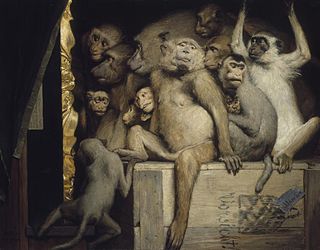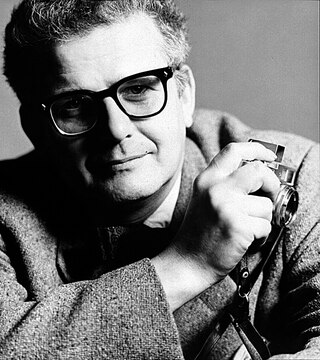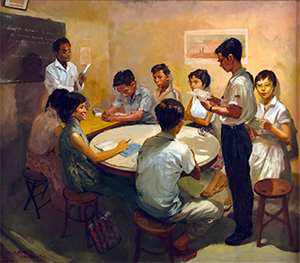History

Under the direction of painter Dorothy Koppelman, [3] the Terrain Gallery opened on February 26, 1955 with the publication of Siegel’s fifteen questions, Is Beauty the Making One of Opposites? (subsequently reprinted in The Journal of Aesthetics and Art Criticism ). [4] Reviewing the opening exhibition, "Intersection '55", Parker Tyler wrote in Art News of the “explicitly inquiring and venturesome spirit” at the Terrain. [5] Bennett Schiff in the New York Post wrote that "there probably hasn't been a gallery before this like the Terrain, which devotes itself to the integration of art with all of living according to an esthetic principle which is part of an entire, encompassing philosophic theory...Aesthetic Realism developed and taught by Eli Siegel". [6]
From the beginning, the Terrain was simultaneously an exhibition space for contemporary art and a cultural center with "a lively and unconventional approach to aesthetic issues" [7] where artists, scholars, and the general public could learn about and discuss principles of Aesthetic Realism, [8] such as "The resolution of conflict in self is like the making one of opposites in art." [9]
Although exhibiting artists were not required to endorse Aesthetic Realism, [6] many wrote comments on the Siegel Theory of Opposites in relation to their work, which were displayed with their art. [10] Over the years, dozens of exhibition announcements, catalogues, and broadsides were printed and circulated by the Terrain, describing how the opposites in reality are central in art. [11]
Artists whose work has been exhibited at the Terrain Gallery include Ad Reinhardt, Larry Rivers, Chaim Koppelman, Robert Blackburn, Roy Lichtenstein, Hans Namuth, Dorothy Koppelman, André Kertész, Mark Di Suvero, Will Barnet, Richard Anuszkiewicz, Richard Artschwager, George Tooker, Lois Dodd, Jim Dine, Elaine de Kooning, and Steve Poleskie. Pop artist Richard Bernstein, optical artist Arnold Alfred Schmidt, photographers Nancy Starrels, Lou Dienes, Nat Herz, and others had their first one-person shows at the Terrain. [10]
Vietnam War protests
In the book The Indignant Eye, Ralph Shikes writes of how the Vietnam War brought many American artists into "active agitation". [12] The Koppelmans were among hundreds of artists who signed their names to an ad in the New York Times protesting the war in Vietnam in 1962. [13] In 1967, 105 painters, sculptors, printmakers and photographers participated in the exhibition All Art Is For Life and Against the War in Vietnam held at the Terrain to benefit napalm-burned and crippled Vietnamese children. Of Chaim Koppelman's print, "Vietnam", Shikes writes that the artist's "protest springs from the art and is not superimposed on it.” [12]
Location changes
First located at 20 West 16th Street, the Terrain Gallery moved in 1964 to 39 Grove Street in Greenwich Village, where it continued to hold art exhibitions and dramatic presentations of Aesthetic Realism. [14]
In 1973 the Terrain moved to SoHo, Manhattan, becoming part of the not-for-profit Aesthetic Realism Foundation located at 141 Greene Street. There, the gallery featured a one-man show of drawings and silkscreens by Charles Magistro, and continued exhibitions such as "Big and Small" ("Art shows that nothing, however small, is without largeness and meaning"), and “The Arts, They’re Here!: Ten Arts and the Opposites," which included music and architecture. [15]
"Art Answers the Questions of Your Life"
In 1984, the Terrain Gallery began a new series of weekly talks, free to the public, called Art Answers the Questions of Your Life. These talks discussed topics such as how precision and abandon are one in Jackson Pollock's action painting, [16] what mothers can learn about children from the art of Mary Cassatt, “Can Exuberance Be Sensible?: Hans Hofmann’s Rhapsody” by Bennett Cooperman, and "Logic and Emotion in Love and in the Shah Nameh by Barbara Buehler. [15] An overview of this series of more than 175 talks on art of diverse genres and periods was presented by co-directors Dorothy Koppelman and Carrie Wilson at the 31st World Congress of the International Society for Education through Art (Teachers College, Columbia University, 2003). [17]
In 2005, the Terrain Gallery held a 50th anniversary exhibition that brought together works by 52 artists, several of whom contributed statements about how the Aesthetic Realism of Eli Siegel influenced their work. [18] A memorial exhibition for Chaim Koppelman, in 2010, included over six decades of the artist's prints, paintings, pastels, and sculpture, with critical comment.










